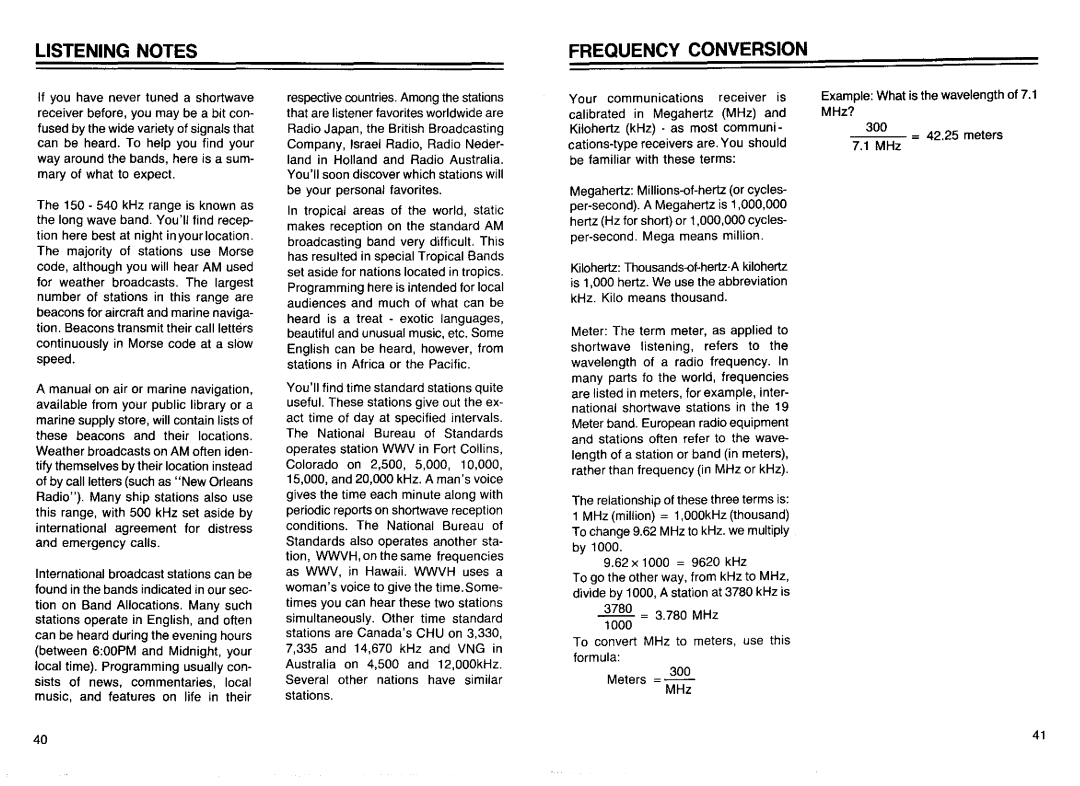
LISTENING NOTES
FREQUENCY CONVERSION
If you have never tuned a shortwave receiver before, you may be a bit con- fused by the wide variety of signals that can be heard. To help you find your way around the bands, here is a sum- mary of what to expect.
The 150 - 540 kHz range is known as the long wave band. You'llfind recep- tion here best at night in your location. The majority of stations use Morse code, although you will hear AM used for weather broadcasts. The largest number of stations in this range are beacons for aircraft and marine naviga- tion. Beacons transmit their call letters continuously in Morse code at a slow speed.
A manual on air or marine navigation, available from your public library or a marine supply store, will contain lists of these beacons and their locations. Weather broadcasts on AM often iden- tify themselves by their location instead of by call letters (such as "New Orleans Radio"). Many ship stations also use this range, with 500 kHz set aside by international agreement for distress and emergency calls.
International broadcast stations can be found in the bands indicated in our sec- tion on Band Allocations. Many such
respective countries. Among the stations that are listener favorites worldwide are Radio Japan, the British Broadcasting Company, Israel Radio, Radio Neder- land in Holland and Radio Australia. You'llsoon discover which stations will be your personal favorites.
In tropical areas of the world, static makes reception on the standard AM broadcasting band very difficult. This has resulted in special Tropical Bands set aside for nations located in tropics. Programming here is intended for local audiences and much of what can be heard is a treat - exotic languages, beautiful and unusual music, etc. Some English can be heard, however, from stations in Africa or the Pacific.
You'llfind time standard stations quite useful. These stations give out the ex- act time of day at specified intervals. The National Bureau of Standards operates station WWV in Fort Collins, Colorado on 2,500, 5,000, 10,000, 15,000, and 20,000 kHz. A man'svoice gives the time each minute along with periodic reports on shortwave reception conditions. The National Bureau of Standards also operates another sta- tion, WWVH, on the same frequencies as WWV, in Hawaii. WWVH uses a woman'svoice to give the time. Some- times you can hear these two stations
Your communications receiver is calibrated in Megahertz (MHz) and Kilohertz (kHz) . as most communi-
Megahertz:
Kilohertz:
Meter: The term meter, as applied to shortwave listening, refers to the wavelength of a radio frequency. In many parts fo the world, frequencies are listed in meters, for example, inter- national shortwave stations in the 19 Meter band. European radio equipment and stations often refer to the wave- length of a station or band (in meters), rather than frequency (in MHz or kHz).
The relationship of these three terms is: 1 MHz (million) = 1,000kHz (thousand) To change 9.62 MHz to kHz. we multiply by 1000.
9.62 x 1000 = 9620 kHz
To go the other way, from kHz to MHz, divide by 1000, A station at 3780 kHz is
Example: What is the wavelength of 7.1 MHz?
7.1 MHz
stations operate in English, and often can be heard during the evening hours (between 6:00PM and Midnight, your local time). Programming usually con- sists of news, commentaries, local music, and features on life in their
40
simultaneously. Other time standard stations are Canada'sCHU on 3,330, 7,335 and 14,670 kHz and VNG in Australia on 4,500 and 12,000kHz. Several other nations have similar stations.
3780 = 3.780 MHz
1000
To convert MHz to meters, use this formula:
300 Meters =
41
